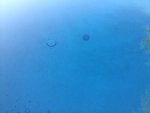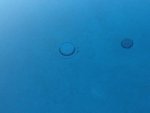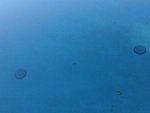As they say on radio "Long time listener, first time caller."
I've spent hours reading many of the posts on this forum and they have been of tremendous help to me. Everything from the simple conversations regarding basic pool chemistry to the months long conversations and experiments regarding the affects of aeration and borates, and the interplay of CYA in chlorine effectiveness. Truly an impressive community. I've never posted because, quite simply, I've had nothing of value to add.
Now however, I find myself confronting what appears to be a hot topic in the pool industry, specifically, the finish in my brand new pool does not look correct, and I am trying to determine if it is a case of what member onBalance describes as "Plaster Discoloration" caused by the addition of "excessive calcium chloride set accelerator, from late hard troweling" or simply, as the pool contractor, would have me believe, the natural appearance of the material. In other words...HELP!
They say a picture is a worth a thousand words, so here is a photo that is a good representation of the mottled appearance of the pool.


The finish is made by CL Industries. It is their Hydrazzo product and the color is Gulfstream Blue mixed with 100% Platino, which should make for a blue-ish grey finish. In some spots this appears to be the case. In others, the finish is a much darker grey, tending toward black, and in other spots much lighter. In fact, because the differences are so pronounced and are spread across the entire finish, I can't even tell you which of the light, mid, dark colors the finish is supposed to be.
A few relevant details:
1) The pool finish was installed in late July, which, here in Jacksonville Florida, means it was HOT.
2) I was on vacation with my family and so I do not know if rain followed immediately after it was finished, or when the contractor started to fill the pool with water (two things I believe, based on my readings, that could cause problems).
3) The chemistry of the pool, which was the responsibility of the pool builder (not the plaster sub-contractor) to maintain, was not maintained. In particular, the pH was consistently above 8.0 during the weeks following the installation.
4) There was a great deal of plaster dust raised whenever the pool was brushed.
5) A few months after the initial installation, the pool was drained, and the finish scrubbed and acid washed by the pool plaster contractor in an effort to reduce or eliminate the uneven finish. I watched this work being performed and was amazed at the amount of dust removed. One could take one's hand and simply rub it along the plaster and rewove large swaths of darkened areas. It was reminiscent of wiping mildew off tile.
6) The pool surface looked better for a few days, but the mottling soon re-appeared.
7) The chemistry was now to be maintained by the finish sub-contractor (as he blamed th pool GC for not doing it right the first time.
8) It wasn't maintained well.
9) The mottling got worse
10) Here we are nine months later...
I've read as much as seems available on the topic, including on this forum and other places:
http://www.troublefreepool.com/threads/50222-Diagnosing-Pool-Plaster-Problems
http://www.troublefreepool.com/threads/41414-Ten-Guidelines-for-Quality-Pool-Plaster
http://www.troublefreepool.com/threads/15442-Problems-With-New-Diamond-Brite-plastered-Pool
http://www.troublefreepool.com/threads/15442-Problems-With-New-Diamond-Brite-plastered-Pool/page2
http://www.poolgeniusnetwork.com/profiles/blogs/gray-mottling-discoloration-of
http://www.poolgeniusnetwork.com/profiles/blogs/white-spotting-in-new-plaster-pools
http://www.poolgeniusnetwork.com/profiles/blog/list?user=2cpgio807ei8z&page=2
http://www.poolgeniusnetwork.com/profiles/blogs/npcs-decree-on-the-saturation
http://poolchloraz.com/links/
and much of it seems to specifically talk about white plaster. I think mine falls into a similar category, as the Hydrozzo product is, per the manufacturer "blended marble aggregate, white Portland cement, graded color aggregate and proprietary ingredients," but would love to know for certain.
A last few details about the pools chemistry:
1) All but impossible to keep the pH below 8.0. Over 10 gallons of Muriatic acid added during March to a 30,000 gallon pool and the pH still spends most of its time between 7.6 and 8.0+
2) Calcium levels are always at 600ppm, which seems awfully high
3) On a possibly related bot, lots of scale on the tile of the outer edge of the vanishing edge and the spillover part of the spa.
4) Alkalinity kept around 75, as the saturation index, due to the pH and Calcium tends to be quite high, especially as the temperature is now rising (at pH 8.0 sat index is approaching 0.9 and will only get worse as the pool warms)
5) No problem with chlorine as I modify output of SWCG to keep it at around 3.0. CYA is 30, but I will raise as summer approaches.
So, the million, or at least few thousand dollar question is, "Is my pool finish appearance the result of poor workmanship, water balance, both, or neither? Any insights are greatly appreciated, and thank you for listening.
----20x40 30,000 gallon plaster, in-ground pool with attached spa, vanishing edge and waterfall, in-floor cleaner, 3 pumps, 3 filters, SWCG, Jandy Aqualink, some lights, switches, valves and gizmos that may or may not do anything, but will certainly break immediately following the end of the warranty period.
I've spent hours reading many of the posts on this forum and they have been of tremendous help to me. Everything from the simple conversations regarding basic pool chemistry to the months long conversations and experiments regarding the affects of aeration and borates, and the interplay of CYA in chlorine effectiveness. Truly an impressive community. I've never posted because, quite simply, I've had nothing of value to add.
Now however, I find myself confronting what appears to be a hot topic in the pool industry, specifically, the finish in my brand new pool does not look correct, and I am trying to determine if it is a case of what member onBalance describes as "Plaster Discoloration" caused by the addition of "excessive calcium chloride set accelerator, from late hard troweling" or simply, as the pool contractor, would have me believe, the natural appearance of the material. In other words...HELP!
They say a picture is a worth a thousand words, so here is a photo that is a good representation of the mottled appearance of the pool.



The finish is made by CL Industries. It is their Hydrazzo product and the color is Gulfstream Blue mixed with 100% Platino, which should make for a blue-ish grey finish. In some spots this appears to be the case. In others, the finish is a much darker grey, tending toward black, and in other spots much lighter. In fact, because the differences are so pronounced and are spread across the entire finish, I can't even tell you which of the light, mid, dark colors the finish is supposed to be.
A few relevant details:
1) The pool finish was installed in late July, which, here in Jacksonville Florida, means it was HOT.
2) I was on vacation with my family and so I do not know if rain followed immediately after it was finished, or when the contractor started to fill the pool with water (two things I believe, based on my readings, that could cause problems).
3) The chemistry of the pool, which was the responsibility of the pool builder (not the plaster sub-contractor) to maintain, was not maintained. In particular, the pH was consistently above 8.0 during the weeks following the installation.
4) There was a great deal of plaster dust raised whenever the pool was brushed.
5) A few months after the initial installation, the pool was drained, and the finish scrubbed and acid washed by the pool plaster contractor in an effort to reduce or eliminate the uneven finish. I watched this work being performed and was amazed at the amount of dust removed. One could take one's hand and simply rub it along the plaster and rewove large swaths of darkened areas. It was reminiscent of wiping mildew off tile.
6) The pool surface looked better for a few days, but the mottling soon re-appeared.
7) The chemistry was now to be maintained by the finish sub-contractor (as he blamed th pool GC for not doing it right the first time.
8) It wasn't maintained well.
9) The mottling got worse
10) Here we are nine months later...
I've read as much as seems available on the topic, including on this forum and other places:
http://www.troublefreepool.com/threads/50222-Diagnosing-Pool-Plaster-Problems
http://www.troublefreepool.com/threads/41414-Ten-Guidelines-for-Quality-Pool-Plaster
http://www.troublefreepool.com/threads/15442-Problems-With-New-Diamond-Brite-plastered-Pool
http://www.troublefreepool.com/threads/15442-Problems-With-New-Diamond-Brite-plastered-Pool/page2
http://www.poolgeniusnetwork.com/profiles/blogs/gray-mottling-discoloration-of
http://www.poolgeniusnetwork.com/profiles/blogs/white-spotting-in-new-plaster-pools
http://www.poolgeniusnetwork.com/profiles/blog/list?user=2cpgio807ei8z&page=2
http://www.poolgeniusnetwork.com/profiles/blogs/npcs-decree-on-the-saturation
http://poolchloraz.com/links/
and much of it seems to specifically talk about white plaster. I think mine falls into a similar category, as the Hydrozzo product is, per the manufacturer "blended marble aggregate, white Portland cement, graded color aggregate and proprietary ingredients," but would love to know for certain.
A last few details about the pools chemistry:
1) All but impossible to keep the pH below 8.0. Over 10 gallons of Muriatic acid added during March to a 30,000 gallon pool and the pH still spends most of its time between 7.6 and 8.0+
2) Calcium levels are always at 600ppm, which seems awfully high
3) On a possibly related bot, lots of scale on the tile of the outer edge of the vanishing edge and the spillover part of the spa.
4) Alkalinity kept around 75, as the saturation index, due to the pH and Calcium tends to be quite high, especially as the temperature is now rising (at pH 8.0 sat index is approaching 0.9 and will only get worse as the pool warms)
5) No problem with chlorine as I modify output of SWCG to keep it at around 3.0. CYA is 30, but I will raise as summer approaches.
So, the million, or at least few thousand dollar question is, "Is my pool finish appearance the result of poor workmanship, water balance, both, or neither? Any insights are greatly appreciated, and thank you for listening.
----20x40 30,000 gallon plaster, in-ground pool with attached spa, vanishing edge and waterfall, in-floor cleaner, 3 pumps, 3 filters, SWCG, Jandy Aqualink, some lights, switches, valves and gizmos that may or may not do anything, but will certainly break immediately following the end of the warranty period.

